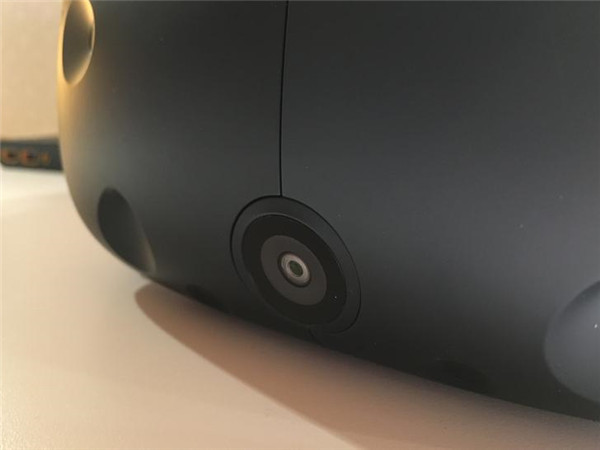
HTC Vive Pre: competing with Oculus Rift.Josh Miller/CNET
You couldn’t walk more than a hundred feet without running into a VR headset somewhere, anywhere, at CES. Foldable cardboard. Plastic headsets. Phone cases. Giant PC rigs with controllers and sensors.
This is supposed to be the “year of VR,” and in some ways it is: this is the year that virtual reality will arrive in a form that can be bought and used in your home. The biggest players in the landscape, the ones we’ve heard about for years, are debuting their wares: Oculus Rift. PlayStation VR. And even HTC Vive.
The vibe I got through the halls at this year’s CES was one of quiet positioning, and eager evangelizing. And even, believe it or not, patience.
The Big Guns: VR’s about to get a lot better, but Oculus Rift and HTC Vive are high-end systems for early adopters
Oculus has dominated the VR conversation for years, and with good reason — its hardware and software solutions have routinely been the best. I remember putting a rickety pair of VR ski goggles on my head in a hotel room back in 2013, and it blew me away. Now, the first consumer-ready version is on its way for $600 (£499 or AU$649) in March.
Well, $600 plus a gaming PC that can handle it. The price and pre-order announcement of Rift cast a shadow over the whole show, by design. Is VR not for the common person anymore? Is it a tech toy only? My answer: of course it’s not for everyone. How many people have hardcore gaming PCs?

What you’ll get if you order Oculus Rift this year.Scott Stein/CNET
That doesn’t make Oculus Rift or its rival, HTC Vive, any less amazing. They’re astounding experiences, and push the boundaries of virtual reality more than anything else. But I bet most people won’t even have tried Oculus Rift or HTC Vive by the end of 2016, much less bought one. I say that because Samsung Gear VR, an amazing mobile virtual reality platform that debuted a year ago, still hasn’t been tried by many people I know…even those who work in tech.
“You, too, can own a VR-ready PC.” Well, maybe, maybe not. The graphics requirements put out by Nvidia, Oculus and Valve for what you’ll need to properly run VR content on your PC would qualify as high-end. There’s an effort being made to show how PCs that can use VR are in arm’s reach. In reality, it’ll be another year or two before the graphics needed spread out to more affordable options.
But for PC hardware vendors, that’s great news in an otherwise stagnant market: PCs that aregraphically-ready for VR were as plentiful, at CES, as the VR headsets themselves.
PlayStation VR sits out the show
The most successful short-term VR system could be Sony’s PlayStation VR. It’ll run on a PlayStation 4 and use existing PlayStation controllers and accessories. Sony’s VR platform was a CES no-show, but it’s lying in wait, scheduled to debut by the first half of this year. But we still don’t know the price yet, or whether it will cost less than Oculus Rift.

The year of the motion controller: HTC Vive Pre’s hardware.Scott Stein/CNET
New inputs, new ways to explore
VR also needs to be smarter and more aware. Google Cardboard uses a simple button on the side of its headset for control; Samsung Gear VR uses an awkward side-mounted touchpad or a Bluetooth gamepad.
Larger systems like Rift, Vive and PlayStation VR, all coming this year, use motion controllers. The Oculus Touch and HTC Vive’s motion-sensing, button-equipped wands accomplish things that are often astonishing. I can open doors, grab things, select tools, and see my hands floating in virtual space. These larger systems all are capable of full-body position-tracking, to greater and lesser degrees.
HTC Vive showed how brilliant it could be to have a camera see through and show a vision of the real world while you’re in a virtual one. A blend of real-life awareness and virtual exploration isn’t just about blending realities, it’s also about safety. Nobody wants to wander their living room and trip over a chair. HTC and Valve call it a “chaperone” system, and it’s exactly what all blindered VR needs.
Motion controllers need to evolve further, to mobile accessories like the Rink concept controller for Samsung Gear VR, or completely peripheral-free hand-scanning. But to really try new controls in VR this year, you’ll need a bigger system like Vive, Rift or PlayStation VR.

Motion control concept: Samsung Gear VR with Rink controllers.CNET
Mobile: where it’s at for now
If you’re going to try VR in the next year, it’ll probably be mobile: sliding a phone into a cheap plastic, cardboard or metal case with lenses, or a customized headset like Samsung Gear VR.
The Samsung Gear VR just debuted in its latest consumer-ready form this past November. Now, the content’s slowly rolling in: games, videos, live streaming, and even a little adult entertainment (if you can figure out how to download it). Google Cardboard, the nearly-free way to play VR on most smartphones, keeps spreading out, with new VR cases and accessories and apps everywhere on the show floor. We made our own VR video, too (technically a 360-degree video, but just like hoverboards, we’ll call these VR videos from now on).
That’s what makes Oculus’ dual-tier strategy of pursuing both a high-end PC-connected tethered Rift, and the wireless, pared-down Samsung Gear VR so smart. Oculus already knows that VR won’t succeed, for now, as a system that only requires being cabled to a desktop computer. In a year or two, the landscape will change and cheaper computers will run VR better. Maybe we’ll finally get tetherless headsets, too. But the cool, portable ease of mobile VR already has its foot in the door.

Sampling extremely uncensored entertainment on a Gear VR.James Martin/CNET
Content makers jockeying everywhere, with mixed results
At this year’s CES you could live VR NBA broadcasts, adult entertainment, and do-it-yourself360-degree VR cameras. Lots to see and do in VR, and this is just the beginning: Hollywood, the gaming industry, and the camera industry all want to make VR their new shining platform. But it didn’t all work perfectly. Far from it. Live-streaming VR is often too blurry for its own good. The so-called VR porn revolution, should you even be seeking that, isn’t welcomed by anyone officially and as such requires awkward sideloading (perhaps, for now, a good thing). And for more 360 degree videos to appear on YouTube and elsewhere, more people will need access to 360-degree cameras. So far, these emerging specialty devices are expensive and limited.

Vuze, a 360-degree 3D VR camera.Seamus Byrne/CNET
VR needs its magic experiences, and the more the better. But what was announced at this year’s show is hardly even a hint of what’s to come. Expect major partnerships, surprising games, and a lot more left-field curiosities throughout the year. Once more VR systems go on sale, the flow of apps should experience a mild explosion. After all, dozens of developers have been steadily working on launch titles for all these systems for years.

The Daqri smart helmet: AR’s role remains enterprise-driven.James Martin/CNET
Augmented reality: enterprise-targeted, for now
The looming next big wave beyond virtual reality could be AR. We’ve seen examples fromMicrosoft HoloLens, and Magic Leap’s promises continue to lurk (despite nearly no one having seen it yet). But for now, AR equals enterprise. It’s not for your living room. Yet.
CES and AR meant industrial use. Intel’s Daqri smart helmet is a classic example — it’s intended for real-life work situations where people can’t use their hands. It’s aimed at being practical, not fanciful. That’s probably because, right now, AR is really hard to do. Augmented and mixed reality I’ve seen doesn’t come close to feeling as wondrous as the best virtual reality. But, the technology was everywhere at CES: Google Glass-like monocular micro-projectors, and bulkier 3D systems. But there’s a dream that regular people will use them. Take Carl Zeiss Smart Optics, building a frame for everyday smartglasses to come.

Scott Stein/CNET
Hungry for your eyes
Over and over again, you can see a certain refrain from VR companies: they all want the industry to collectively succeed. They’re still all on a quest to get your eyes into VR. And that’ll still be the major challenge this year. Will you buy VR? And will you even get a chance to try it on? A ton of people hope you do.
Source:http://www.cnet.com/news/everyone-wanted-a-piece-of-virtual-reality-at-this-years-ces/
Releated Guides for Gear VR Owners:
- Rip 3D Blu-ray to 3D SBS MKV for Samsung Gear VR
- Watch 3D movies on Galaxy Note 4 for Samsung Gear VR
- Solution of Issue about DVD Playback in TV with Gear VR + Chromecast
- Rip 3D Blu-ray to 3D SBS MKV to Watch in Samsung Gear VR Unit
- Remove iTunes DRM and make SBS 3D to Gear VR with Galaxy Note 4
- Play Digital Copy in Galaxy S6 with Gear VR Innovator Edition
- Rip 3D Blu-ray ISO files to Samsung Gear VR using XBMC
- Watch 3D Blu-ray on Cardboard, Oculus Rift, 3D TV via Roku
- Rip ISO files to 3D SBS MP4/MKV for viewing on Gear VR
- Make Plex to stream a DVD for watching on my virtual reality Gear VR
- Get 3D Blu-ray onto Plex for Perfect Streaming in Panasonic VT65 3D Smart TV
- Convert Sony 3D HDR-TD30V MVC/AVCHD to SBS MP4 MKV for LG 3D TV
- Rip 3D Blu-ray to 3D MP4 and play on your 3D players with desired subtitles
- How to create 3D MKV video out of 3D ISO movies
Have more questions about how to play 3D movie on any 3D devices, please feel free to contact us>>









Leave a Reply
You must be logged in to post a comment.